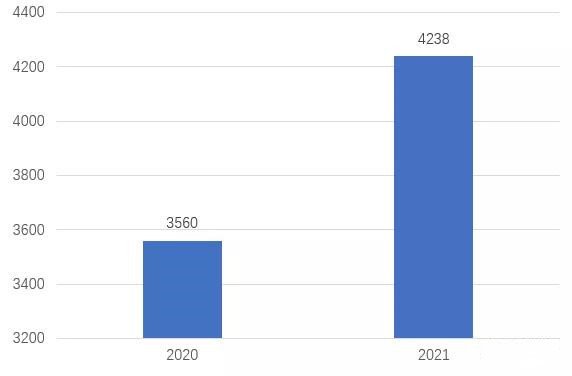As consumers pay attention to the nutrition and health market, the channels for people to obtain information are constantly diversified and segmented. One of the biggest drivers of this change is technological innovation, as consumers’ understanding of “health” continues to fragment. Numerous websites, apps, and social media platforms enable consumers to conduct their research. Armed with this knowledge, people are more confident in creating personalized healthy eating patterns and dietary choices.
Recently, data released by New Nutrition Business in the United States pointed out that key trends such as plant-based, mood management, probiotics, and nutrient density will become the driving force of global functional food and beverages in 2022.
1 Meat vs Plant Based
U.S. meat snack sales will grow 19% in 2021 to $4.2 billion. This reflects that they are very well suited to the needs of many consumers. Meat snack brand The Old Wisconsin achieved retail sales of $165 million in 2021, a 24% increase from 2020. It focuses on origin, naturalness, and strong consumer appeal with 9 grams of protein and 13 grams of fat per 56 grams. By comparison, it’s worth noting that sales of plant-based meats (sausages, burgers, etc.) over the same time were only $1 billion, a growth rate of 10%. Health-conscious consumers are looking for tasty, filling, low-carb, low/sugar, naturally high-protein snacks. Many brands are already promoting the sustainability aspects of their products (for example, grass-fed), which helps reach more consumers.

Consumers’ desire for “what works for me” makes them flexible and open to innovation. Women of all ages, especially Gen Z and younger millennial female consumers, are keen to embrace cowhide-derived “bovine collagen.” Collagen has become an essential breakfast element for more and more young women, such as adding collagen powder to breakfast shakes. Nestlé has entered the collagen field, acquiring the US “Vital Proteins” and launching the product on the largest online retail channels in Europe and China.
2 Innovative forms of products
Skincare is one of the most striking highlights of collagen. Aside from weight management, what people want most is to look and feel good.
Consumers want more plant-based elements in their diets for their powerful health halo but also want more convenient forms. Over the past decade, creative product developers and ingredient manufacturers have devised many ways to make it easier to incorporate a certain percentage of vegetables into packaged foods. From snacks to bread, side dishes, and mini-meals. Vegetables have also successfully become a healthy alternative to starchy carbohydrates and are increasingly common in supermarkets. “Plant information” on product labels gives people the right to indulge, and it’s one of the most effective marketing messages.

3 The vegetable protein paradox
Currently, plant proteins face a paradox. Consumer interest is high and demand is growing, especially for easy-to-understand, less-processed products such as almonds and pistachios. Plant-based protein can be added to bread products such as wraps and tortillas. But for many end-product applications, there are technical and taste challenges. As a result, plant-based proteins are often offered as part of specialty ingredients, resulting in complex ingredient lists, as opposed to the clean label that health-conscious consumers have always wanted.
This challenge is evident in the field of plant-based meat alternatives. According to IRI, its market size is only $1 billion, which is not even comparable to a market like meat snacks. The growth rate in 2021 is 10%, but at this rate, it will take another 10 years to make an impact on animal protein.
Currently, plant proteins face a paradox. Consumer interest is high and demand is growing, especially for easy-to-understand, less-processed products such as almonds and pistachios. Plant-based protein can be added to bread products such as wraps and tortillas. But for many end-product applications, there are technical and taste challenges. As a result, plant-based proteins are often offered as part of specialty ingredients, resulting in complex ingredient lists, as opposed to the clean label that health-conscious consumers have always wanted.
This challenge is evident in the field of plant-based meat alternatives. According to IRI, its market size is only $1 billion, which is not even comparable to a market like meat snacks. The growth rate in 2021 is 10%, but at this rate, it will take another 10 years to make an impact on animal protein.

Products underperform in terms of taste, texture, nutrition, and versatility, not to mention price. Not all alternative manufacturers have had their way. With a 23% market share, Beyond Meat is the second-largest brand, and losses occur from time to time, and increasing sales by cutting prices will only make it more costly.
One of the continued growth opportunities for plant-based products is powders. They are convenient, fast, versatile, and portable. For many, powders are a way to get more plants into their lives in a clean, nutritious way. Millennials have embraced them, and for Gen Z, they are just a normal part of life. In addition, American habits are being embraced by younger consumers in Europe, where more and more stores have a dedicated plant-based powder section. Unsurprisingly, the plant powder business is growing steadily at an annual rate of 8%.
4 Emotional & Mental Health
For more than 10 years, mood and spirit improvement products have been the focus of research and development by mainstream companies. Consumer interest is high, and the problem is that a lot of startups and challenger brands have tried to fail, or survive as niche businesses. The reason is simple, a lot of products don’t give consumers the benefits they feel, or at least they don’t think they feel the change.
Plenty of mood and spirit products with cool brands, fun ingredients, social media campaigns. But they mostly fail because of the lack of science, and for science-based companies, these challenges are opportunities.
5 Market Opportunities for Probiotics
Numerous scientific studies have found that probiotics have the potential for emotional and spiritual applications. This is partly because society and mainstream media are talking about the gut-brain connection, so there is a certain consumer base. The use of probiotics for mood and thinking is more credible to consumers. Some mainstream brands are also beginning to communicate this connection to consumers, such as Lifeway Kefir. This is an emerging field that requires long-term focus to be successful.
At present, consumers have oversupplied the choice of probiotic products. Whether commercializing probiotic ingredients or finished consumer products, marketing creativity now trumps science. For a probiotic company to succeed, it must be a persuader to consumers, marketers, and scientific data.
British probiotic brand Symprove is a good example of the effectiveness of this strategy. Symprove has developed a liquid food supplement containing four types of probiotics. It works with King’s College London and University College London to conduct extensive data trials that demonstrate the science and safety of its products.
In a market that doesn’t allow any health claims, the company’s success can be directly attributed to the brand’s focus on a direct-to-consumer business model. This allows it to better communicate with consumers and get consumer feedback. At present, many new health consumer brands in the Chinese market follow the DTC model, designing and iterating products directly from the consumer level.
In contrast to Symprove, New Zealand company Blis Technologies has long been making a case study in the commercialization of probiotics science. But sales had been sluggish for 15 years before the company turned a profit. It has adopted a strategy of becoming an expert in market, consumer, scientific data and, like Symprove, is focused on growing a strong D2C business.
When it comes to probiotic ingredients, the future of the market may be in the hands of companies with scientifically validated strains and extensive distribution networks. The future of probiotics is bright, but so is the competition. Consumers have so many choices that success requires more creativity than ever.
6 Nutrient density is starting to catch on
The concept of nutrient density has been around in the nutrition community for over 20 years, but it has grown rapidly in the past two or three years. The term nutrient density has been adopted by the American Dietary Guidelines.

Nutrient density is becoming a marketing term. One of the appeals of the term for marketers is that there is no uniform definition, either in terms of regulation or in the minds of consumers. In terms of company strategy, it can be linked to important issues including sustainability (such as soil health and regenerative agriculture), bioavailability, and the growing scientific and consumer focus on ultra-processed foods.
Everyone loves to discuss consumer trends, especially for emergencies, but it takes a long-term view. Secondly, whether the product has good taste and texture is the key factor for the success of marketization. Finally, under the premise of obtaining considerable profits, enterprises need to invest in scientific research and development of products for a long time. These factors will become the basis for adapting to consumption trends.

